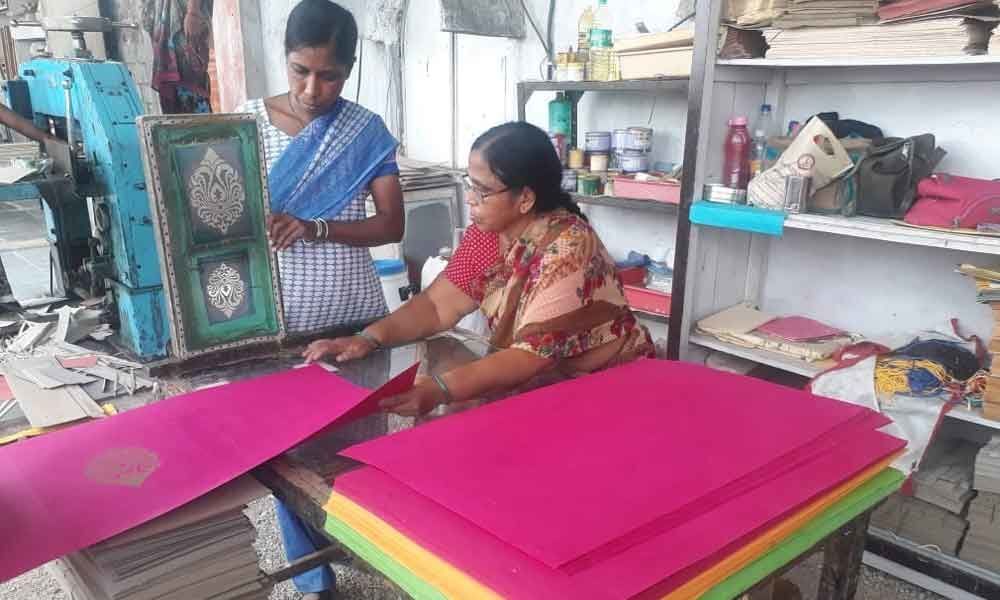Live
- WPL 2025: Matthews, Sciver-Brunt and Harmanpreet carry MI to massive 213/4
- MLA Anirudh Reddy Accuses KTR of Involvement in Manhattan Project Scam
- TGPSC Clarifies on False Propaganda Regarding Group-1 Recruitment
- Hyderabad Police Ensures Security as Holi and Ramadan's Second Friday Coincide
- Five MLCs Elected Unopposed in Telangana Under MLA Quota
- Sambhal prepares for a peaceful Holi with tightened security and special patrols
- CNG, PNG prices to become cheaper in Rajasthan from March 14
- Anti-Rape ad to screen in theaters before movies, like health advisories
- Prodigy Finance Offers Three Scholarship Awards totalling an amount of $19,000 for Global Students Starting Fall 2025
- Champions League drama likely to affect La Liga with big games this weekend
National Institute of Rural Development initiative gives new hope to rural jobless


The rural employment generation initiatives under National Institute of Rural Development and Panchayati Raj (NIRD-PR), located at Rajendranagar, is now creating a ray of hope for those men and women who are in need of employment to survive in rural areas and left with no choice, but to migrate to cities in search of livelihood.
Rajendranagar: The rural employment generation initiatives under National Institute of Rural Development and Panchayati Raj (NIRD-PR), located at Rajendranagar, is now creating a ray of hope for those men and women who are in need of employment to survive in rural areas and left with no choice, but to migrate to cities in search of livelihood.
According to officials, the initiative includes beekeeping & honey processing, Soya processing, Mushroom cultivation and processing, bio-pesticides and Neem based products, vermin compost preparation, leaf plate making, natural dye making, handmade paper manufacturing, herbal cosmetics, tribal and fashion jewellery, solar dehydration technology, ethnic cloth bags, home-based products, aromatic crop cultivation & extraction of essential oils, clay process and crafts, lead light manufacturing, electro spark coating and eco-hatchery.
For each course the duration for training differs from 2 to 10 days according to the length and scale of the throughput involved in the programme. Almost every entrepreneurship skill development facility that is considered as essential for the development of rural men and women is being employed under one roof at NIRD to support and encourage those men and women folk who are ambitious enough to stand on their feet and prosper further with their zeal.
"The Rural Technology Park of NIRDPR is providing training for various self-employment oriented skill development training programmes for both unemployed men and women under one roof. Soon after the completion of a brief training process, the men and women would assimilate into the industry based on their ability," said Mohammad Khan, a senior consultant NIRD.
One such entrepreneurship programme, a handmade paper manufacturing unit was set up in the NIRD, Rajendranagar, through the Public Private Partnership (PPP) initiative, wherein several women are now being employed and all of them are completely specialised in the work they are assigned with. Since these women are trained enough to carry out all sort of works independently in the unit, there is no need to involve an extra masculine activity in the process of production, which is perceive quite necessary in other workshops. The entire process involve 100% women participation and it is completely organic.
100% women workforce
The manufacturing process involves 100% women participation. The production in the manufacturing unit is also above and beyond expectation. "The unit makes about 70 to 80 kg of handmade paper per day that worth Rs.18, 000 in the market. Presently, there are 30 women working in the workshop, and they are being paid Rs 250 to Rs 400 per day depending on the nature of work they are assigned to. The unit with its environment-friendly approach make variety of papers with different natural colours and texture that sooth your eyes," Ravinder Rao added.
As far as the work culture is concern, the women folk work here in an affable manner same as it is witnessed in any another community-based services. Those who are unable to be in the unit on daily basis, work from home option is also available. The work-from-home facility attracts many household women to become a part of the unit distantly and to earn a side income quite sitting at their homes.
Ravinder Rao, who is also a proprietor of the unit called Gandhi Handmade Paper Unit at NIRD, supplies material to the nearby household and recover it from them after completion of the work. "We pay them Rs 250 to Rs 400 per day depending on the nature of the work. The adequate part of the production caters the day-to-day needs of the NIRD, and the remaining portion moves out to fulfil the market demand," he added.
SHOWING LIVELIHOOD
Almost every entrepreneurship skill that is considered as essential for the development of rural men and women is being employed under one roof at NIRD to support and encourage those men and women folk who are ambitious enough to stand on their feet and prosper further with their zeal Soon after the completion of a brief training process, the men and women would be assimilated into the industry, based on their ability
– Mohammad Khan, Senior Consultant, NIRD
Paper Manufacturing Process
All the waste stuff like used paper and thrown-out cotton rags that brought from the government offices and warehouses were minced into pieces using Rag Chopper. Later, the chopped waste was released into the Beater Machine where the stuff was cleansed into water for almost 6 to 7 hours until the whole stuff turns into pulpy mess.
Subsequently, the Sheet Former Machine is used to compress the whole pulpy stuff thus get ready the wet mat of fibre. The Calendar Machine is then used to give a finishing touch to the wet mat. With this, the dried stuff turns into a stiff and flexible paper web. Pearl powder is being used to make the paper look bright and shine.
Recycling the waste
The waste material, such as usable paper and waste cottons rags that are largely collected from government offices and warehouses, is being used to manufacture handmade paper through recycle process, and that to, in a complete environmentally- friendly manner. Neither the chemical nor the chemical-induced colours are used in the process.
"The unit is a perfect model for an organic way of manufacturing. Only natural ingredients that are extracted from vegetables and fruit are used to bring out a best quality paper, on par with the stuff already available in the market,'' said J Ravinder Rao, who runs the paper manufacturing unit at NIRD through PPP initiative.
"Colour pigments extracted naturally from vegetables and fruit are used to dye the paper. This makes the paper more flexible and increases its sustainability compared to the paper generally made out of chemical compound and widely available in the market. The paper is a best alternative to the plastic and chemical-based products as both the stuff pose a great risk to the human health and the environment. The handmade papers are totally environment-friendly," he added.

© 2025 Hyderabad Media House Limited/The Hans India. All rights reserved. Powered by hocalwire.com






